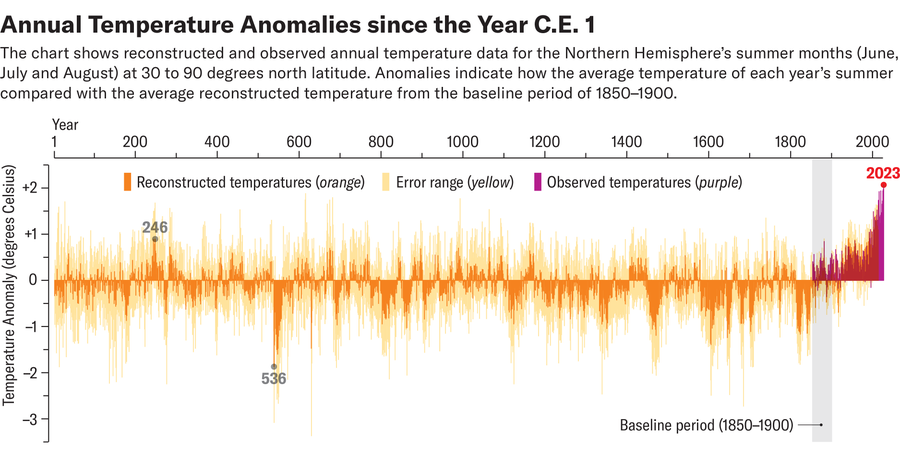Heat wave after punishing, record-shattering heat wave gripped regions all over the Northern Hemisphere this past summer. They contributed to the globally hottest month, weeks and day ever in more than 100 years of direct measurements and to 2023 being the hottest year on record by a wide margin. Now a new study shows that that summer in the Northern Hemisphere was the hottest in the past 2,000 years—a marker of how much the world has already warmed and how urgently we need to drastically reduce greenhouse gas emissions, the study’s authors say.
The findings were published on Tuesday in Nature and were based on reconstructions of ancient temperatures from tree rings. They show that beyond being 0.15 degree Celsius hotter than the previous record-setting summer of 2016, the summer of 2023 was at least 0.5 degree C hotter than the warmest summer that occurred before humans began raising the global temperature by burning fossil fuels. “The trees tell us that 2023 was exceptionally warm,” says study co-author Jan Esper, a dendrochronologist and climate scientist at Johannes Gutenberg University Mainz in Germany.
Esper and his co-authors were motivated to find 2023’s long-term climate ranking based on both how exceptional the heat overall how the media and some experts had asserted that certain days and weeks during that season were likely the hottest in 120,000 years. But the climate records from ice sheets and sediment that go back that far have a resolution of about 300 years, Esper says, so we cannot make a meaningful comparison from the records to individual days, weeks or even years.
On supporting science journalism
If you're enjoying this article, consider supporting our award-winning journalism by subscribing. By purchasing a subscription you are helping to ensure the future of impactful stories about the discoveries and ideas shaping our world today.
So the researchers turned to tree rings. Unlike direct measurements by humans, which only extend back a little more than 100 years and are often limited to just a few places, mostly in Europe, trees can provide indirect temperature data that go back thousands of years. Trees growing in temperate climates produce discernable rings as they grow each year—and how much they grow is related to the seasonal temperatures they experience.
There are still limitations to these paleoclimate records: tree ring records from the Southern Hemisphere are lacking, and tropical trees don’t display the same annual rings as temperate trees because they don’t experience winter. So Esper and his co-authors confined their analysis to the area of the Northern Hemisphere between 30 and 90 degrees north latitude.

Based on those records, the summer of 2023 was clearly the hottest in the past 2,000 years. Last summer’s temperature proved to be at least 0.5 degree C above that of C.E.246—a time that was the hottest summer before direct measurements began and long before human-caused warming emerged.
The researchers also found that last summer was as much as 3.93 degrees C hotter than that of C.E. 536, which was the coldest summer in the tree ring records because of a volcanic eruption that shot sunlight-reflecting particles into the atmosphere.
Although the findings aren’t surprising, given how well climate scientists understand the trajectory of the global warming trend, “it’s pretty impressive that you can go 2,000 years back and know that we’re hotter than any of those individual years,” says Vikki Thompson, a climate scientist at the Royal Netherlands Meteorological Institute, who was not involved in the new study.
Esper says 2023 likely doesn’t mark a major leap in warming. Rather “I think it’s just a continuation of a trend,” he says. Such heat “was expected, maybe not in this particular year” but within this decade or so.
Esper adds that he hopes that the findings will underscore the urgency of curtailing greenhouse gas emissions and leaving fossil fuels behind. “I naively hope that we will limit our greenhouse gas emissions,” he says. “The latest numbers are not promising at all, but I do see change.”
Esper also wants to gather more tree ring data to make such temperature reconstructions more robust and cover a wider swath of the planet. He is hoping to drill for tree rings in the U.S. this year, although it can be difficult to get permission because of environmental protections, he says. Given the upheaval that climate change is causing, including to forests, however, Esper sees his paleoclimate work as necessary for that same goal. “We want to protect the trees,” he says.
